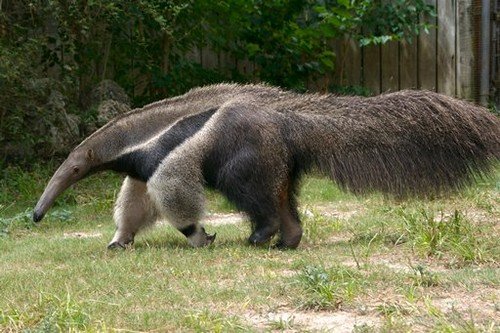
Now, let’s dig deeper into the anatomy and behavior of these fascinating animals. Whether you’ve stumbled upon them in documentaries or plan to visit a wildlife sanctuary, understanding their nature might just enrich your experience. So, can anteaters be dangerous to humans? Here’s what you need to know.
Understanding Anteater Behavior
Anteaters are unique creatures primarily found in Central and South America. They come in several species, but the Giant Anteater is the most well-known. These animals are generally shy and prefer to avoid confrontation. Think of them as introverts at a party—they’d rather stick to the corners and munch on ants and termites than engage in any drama. This isn’t to say they won’t defend themselves if they feel threatened.
When they’re provoked, anteaters can use their sharp claws and powerful legs. Imagine a rather large, well-built friend who only fights back when pushed too far. Anteaters typically stand on their hind legs and swipe with their claws if they feel there’s no other option. While it’s rare for them to go on the offensive, anything is possible when they sense danger.
Physical Attributes That Can Be Dangerous
You might think that a creature with a diet focused on ants would be mostly harmless. However, let’s break down a few key physical characteristics of the anteater that can make it potentially dangerous:
- Claws: Anteaters have long, sharp claws that can inflict injury. These claws are designed for digging into anthills or termite mounds, but they’re also effective as a defense mechanism.
- Size and Strength: The Giant Anteater can weigh up to 100 pounds and reach lengths of over 7 feet. Their size alone commands respect, and they have the strength to back it up if needed.
- Defensive Posture: When threatened, anteaters can stand on their hind legs, making them appear larger and more intimidating. It’s like a cat puffing up to scare off a dog; they’re not looking for trouble, but they’re ready to defend themselves.
With these attributes, it’s vital to remember that while anteaters don’t seek out conflict, they’re equipped to handle threats when necessary.
Incidents of Anteater Attacks
Now that we know anteaters can defend themselves, let’s talk about actual incidents. You might be wondering how often these creatures actually interact negatively with humans. Believe it or not, documented cases of anteater attacks on people are quite rare. Most encounters with humans end peacefully, with the anteater simply scuttling away.
That said, there have been reports, particularly in rural areas where these animals come into contact with humans more often. For instance, locals might encounter anteaters while foraging for food or when the animals wander into populated areas searching for food. In such cases, if an anteater feels cornered, it may resort to defensive behavior.
In one notable instance in Brazil, a man was attacked while trying to approach a Giant Anteater. He learned the hard way that these animals should be admired from a distance. So while dangerous encounters are not commonplace, it’s important to treat anteaters with respect.
How to Safely Observe Anteaters
If you’re lucky enough to see an anteater in the wild or at a zoo, you might wonder how to enjoy the experience safely. Here are a few tips:
- Keep Your Distance: Respect the animal’s space. Use binoculars or zoom lenses for better views without intruding.
- Avoid Cornering: If you see one in the wild, don’t surround or get too close. Allow it an exit route to retreat if it chooses.
- Follow Guidelines: If you’re visiting a sanctuary or zoo, adhere to all safety rules and guidelines provided by staff. They know how to keep both you and the animals safe.
By following these tips, you can enjoy observing anteaters and appreciate their uniqueness without putting yourself or the animal at risk.
Comparing Anteaters to Other Wildlife
When discussing potential dangers in wildlife, anteaters often get compared to other animals like raccoons or even domestic pets. Both can exhibit aggressive behavior if they feel threatened, yet they don’t typically seek out confrontation. For example, you wouldn’t pet a raccoon you found rummaging through trash; similarly, it’s wise to keep a respectful distance from an anteater.
Another comparison can be made with bears. Like anteaters, bears will avoid humans when they can. However, if a bear feels cornered or threatened, it can be dangerous. The takeaway is that, regardless of the animal, the best approach is always to stay safe by giving wildlife their space.
The Importance of Conservation
Finally, let’s talk about why understanding anteaters’ behavior is crucial for conservation efforts. As their habitats are threatened by deforestation and urbanization, these animals are increasingly coming into contact with humans. Unfortunately, this often leads to misinterpretations of their behavior.
By spreading awareness about anteaters and their habits, we can foster a better understanding that reduces unnecessary fear. After all, these creatures play a vital role in their ecosystems by controlling insect populations. Supporting conservation efforts helps protect both the anteater and its habitat, allowing future generations to appreciate them in their natural environment.
In conclusion, while it’s true that anteaters can be dangerous if provoked, most interactions with humans are peaceful. By respecting their space and understanding their nature, we can coexist with these remarkable creatures. So next time you think about anteaters, remember: they’re not just quirky critters; they’re also complex animals that deserve a little extra insight and respect.
